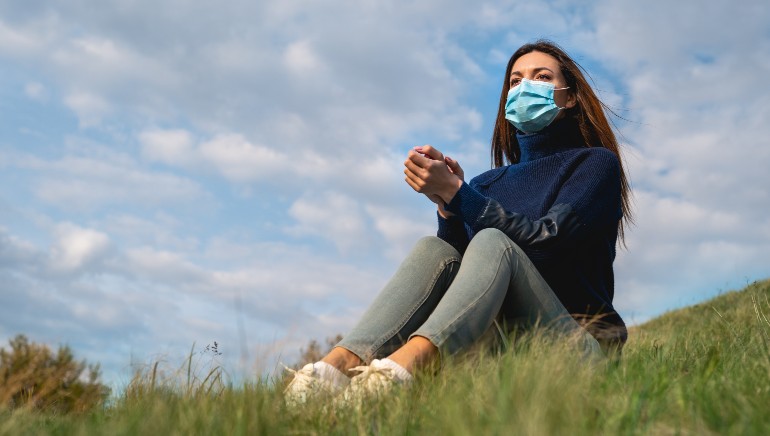
How to prevent altitude sickness: Tips to avoid acute illness
7 months ago | 79 Views
Chinmay Sharma, a 27-year-old man from Uttar Pradesh, died in Leh reportedly due to altitude sickness, which is caused by low levels of oxygen in the air. The man went to the high-altitude area on his motorcycle. During his solo trip, he reportedly started having headaches and difficulty in breathing, and later passed away in a hospital. Altitude sickness can lead to headache, tiredness, nausea, and vomiting. It can also be life-threatening, so make efforts to prevent altitude sickness if you are travelling to a high-altitude place, usually more than 2500 metre above sea level.
What is altitude sickness?
Altitude refers to a place's height above the sea level. "When you are at higher altitudes, the atmospheric pressure drops, resulting in less oxygen available for your body to use," says pulmonologist Dr Jayalakshmi T K. Altitude sickness occurs when the body struggles to adapt to the lower oxygen levels and reduced atmospheric pressure. This can happen when people ascend too quickly to high altitudes without allowing adequate time for acclimatization. People may start noticing symptoms of altitude sickness six to 10 hours after being at a high altitude, according to the UK's National Health Service.

What are the types of altitude sickness?
Here are the types and symptoms of altitude sickness -
1. Acute Mountain Sickness
"This is the most common form of altitude sickness, but it is also the least severe," says the expert. The percentage of non-acclimated people affected by Acute Mountain Sickness at 3000 metres is around 75 percent, according to research published in StatPearls in 2023. Some of the symptoms headache, nausea, dizziness and fatigue.
2. High Altitude Pulmonary Edema
This is a more severe condition where fluid accumulates in the lungs, impairing oxygen exchange. Symptoms include severe shortness of breath, persistent cough and a feeling of tightness in the chest.
3. High Altitude Cerebral Edema
"This is the most dangerous type of this condition, which involves brain swelling," says Dr Jayalakshmi. Symptoms are severe headache, confusion, loss of coordination, hallucinations and loss of consciousness.
Altitude sickness can become life-threatening when a person has High Altitude Pulmonary Edema or High Altitude Cerebral Edema. "Both conditions can progress quickly and lead to severe complications or death if not addressed promptly," says the expert.
What are the risk factors?
Here are some of the risk factors of altitude sickness:
1. Rapid ascent
Ascending to high altitudes too quickly significantly raises the risk of altitude sickness. When you climb or travel to high elevations rapidly, your body has insufficient time to adapt to the decreasing levels of oxygen and lower atmospheric pressure. This can overwhelm the body’s ability to acclimate, leading to symptoms such as headaches, nausea, and dizziness. "For instance, ascending from sea level to 3,000 metres within a single day can increase the likelihood of developing altitude sickness," shares the expert.
2. Previous history
People with a history of altitude sickness are at an increased risk of experiencing it again. Past episodes of altitude sickness suggest that their body might have a reduced capacity to acclimate to high altitudes. This susceptibility may be due to inherent physiological or genetic factors that make their adaptation process less efficient. As a result, those who have previously suffered from altitude sickness should take extra precautions, such as slower ascents and more rigorous acclimatization protocols, to reduce their risk.
3. Physical exertion
Engaging in strenuous physical activities shortly after arriving at high altitude can exacerbate the risk of altitude sickness. High-intensity exercise increases the body's oxygen demand, which is difficult to meet at high elevations where oxygen is scarce. This additional stress can overwhelm the body's adaptation mechanisms and precipitate symptoms of altitude sickness. For example, hiking vigorously or climbing immediately upon arrival at high altitude without proper acclimatization can lead to more pronounced symptoms.
4. Existing medical conditions
People with pre-existing respiratory or cardiovascular conditions may face an increased risk of altitude sickness. "Conditions such as chronic obstructive pulmonary disease, asthma, or heart disease can impair the body’s ability to handle reduced oxygen levels and lower atmospheric pressure," shares the expert. These conditions can exacerbate the physiological strain caused by high altitudes, making acclimatization more difficult and increasing susceptibility to altitude sickness.

How to treat altitude sickness?
The treatment depends on the type of altitude sickness.
- The primary treatment and management of altitude sickness involves descending to a lower altitude, resting, and staying well-hydrated. "Over-the-counter medications like ibuprofen can provide relief from headache or discomfort associated with the condition," says the expert.
- In case of High Altitude Pulmonary Edema, immediate descent is crucial. Supplemental oxygen will be given, and medications such as nifedipine may be used to manage the symptoms.
- As for High Altitude Cerebral Edema, corticosteroids can help reduce brain swelling. Supplemental oxygen and close monitoring are also needed.
How to prevent altitude sickness?
Whenever you travel to a high altitude location, make sure you prepare well. Keep these points in mind to prevent altitude sickness:
1. Acclimatization
According to the health advisory given by the Administration of Union Territory of Ladakh, travelers need to undergo at least 48 hours of acclimatization before going to high altitude areas. Proper acclimatization involves gradually increasing altitude and allowing the body to adjust to reduced oxygen levels. "Without sufficient time spent at intermediate altitudes, such as spending a few days at 2500 meters before ascending to 3500 meters, the risk of altitude sickness increases," says the expert.
2. Gradual ascent
Be slow while climbing up if you don't want to have altitude sickness. "You should increase your altitude by about 300 to 500 meters in day once you reach a place above 2500 metres," says the expert.
3. Hydration
Maintain good hydration by drinking plenty of fluids like water or healthy fruit juices. But avoid drinking alcohol and caffeinated beverages, as they can exacerbate dehydration.
4. Avoid excessive exertion
Make sure not to physically exert or push yourself in the first 24 to 48 hours at a high-altitude place. Resting and not exerting yourself will reduce the risk of altitude sickness.
5. Choose lower altitude for sleeping
During the day, travel to a higher elevation, but returning to a lower altitude for sleeping, recommends the US Centers for Disease Control and Prevention. The symptoms of altitude sickness tend to get worse at night while sleeping, so choose a lower altitude for sleeping.
6. Medications
"Prophylactic medications such as acetazolamide may be prescribed to help prevent altitude sickness," says the expert. But take them only after consulting with a doctor, who can give advice on the basis of your travel plans and health status.
Read Also: Baby carrots for great glowing skin: A diet staple we should all follow
#




















